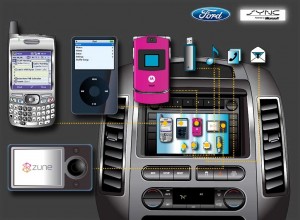
Ford's latest Sync update permits th maker to draw a number of smartphone apps into the vehicle, including the Pandora music service.
Depending upon your point of view about in-car technology, the announcement from Ford could be seen as good news or bad news – or perhaps a little bit of both.
The maker this month produced its 10 millionth vehicle equipped with the Sync infotainment system. That’s just six years after Ford first rolled out the technology developed in cooperation with tech giant Microsoft.
“SYNC has helped us to think and act more like a technology company,” said Jim Farley, Ford executive vice president of global marketing, sales and service. “It has forever changed how we look at our business and how we respond to our customers.”
Since its introduction, Sync has fostered some major changes in the auto industry and there’s not a brand to be found today that isn’t offering at least a basic in-car infotainment system. But while Ford claims Sync – and the MyFordTouch and MyLincolnTouch infotainment systems – have drawn plenty of young, tech-savvy buyers into the brand’s showrooms, the technology has also created plenty of headaches for owners and for Ford which has seen its quality ratings tumble, in large parts due to problems with its infotainment systems.
In the annual Consumer Reports automotive reliability survey released a month ago, full 17% of owners reported having problems with the technology on the Detroit maker’s C-Max model, the plug-in version of that people-mover coming in dead last among all models in the CR owners’ survey.
Ford has tumbled in nearly all recent quality and reliability surveys, and though the maker has experienced some traditional mechanical problems, especially with the double-clutch gearboxes on small models like the Fiesta, by far the biggest issue has been centered around problems with its infotainment technologies.
But Ford is not the only maker running into trouble with this new technology. “Manufacturers are doing a lot better when it comes to engines and chasses and other mechanical systems,” explained Dave Sargent, the head of automotive research for California-based J.D. Power and Associates. “Most of the problems people are now reporting involve the latest technology.”
(Manufacturers stumble as consumers gripe about infotainment problems. For more, Click Here.)
Indeed, two out of every three problems reported by the 83,000 owners and lessees who participated in JDPA’s 2013 Initial Quality Survey were tech-based. While that includes such electro-mechanical devices as electronic suspensions and cruise-control systems, the bulk of the complaints involved systems like the FordMyTouch, explained Sargent, noting that owners were particularly frustrated by:
- User interfaces that made it difficult to do even the simplest tasks, such as changing temperature or tuning the radio;
- Voice control systems that couldn’t understand commands or executed them incorrectly;
- Systems that would not pair with a motorist’s smartphone.
For their part, Ford officials acknowledge they’ve been facing trouble but insist they have been making significant progress, reducing by as much as two-thirds the number of complaints over the last year with updates – both software and hardware – to the company’s infotainment technology.
Ford’s Farley contends that the maker has to accept it will frustrate some buyers who simply don’t know how to work the latest technologies. The same systems are a big draw to more tech-savvy customers.
“Owners desire, and in some cases are demanding, more content in their new vehicles, especially technology-related features, and automakers are trying to provide it,” agreed Power’s Sargent. While he said ““The majority of owners don’t experience problems, those who do are frustrated.”
(New Ford acquisition could put more smartphone apps on your dashboard. Click Herefor more.)
Ford is showing no sign of backing down from its commitment to Sync. If anything, it recently purchased the Detroit-based tech start-up Livio which specialized in finding ways to bring more smartphones apps into the car. But Ford also plans to offer at least a few more buttons and knobs on future models, accepting the demand by motorists to give then traditional mechanical controls for functions – such as climate control – that can be frustrating to operate when it requires a user to scroll through several pages of onscreen commands.

That means Ford has 10 million more dangerous vehicles on the roadways…